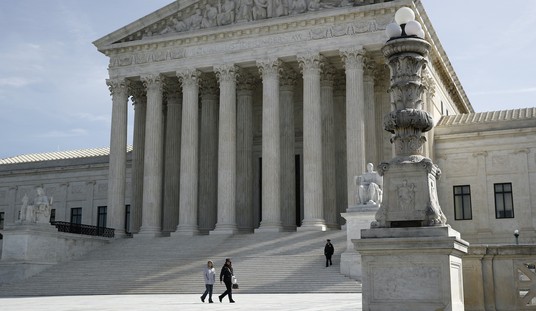President Donald Trump is not one to mince words, and that includes voicing his disapproval of Federal Reserve Chairman Jerome Powell. Although Trump says he won’t fire Powell, he would certainly be justified in doing so—Powell played a key role in making Americans poorer, all while breaking the law.
It was Powell’s non-stop money printing that fueled former President Biden’s runaway government spending which, predictably, devalued the dollar and gave us 40-year high inflation. While prices skyrocketed, Powell called inflation “transitory” and said he wasn’t concerned with the disturbing trend.
Worse, to ensure his renomination under Biden, Powell promised that interest rates would stay artificially low indefinitely. That enticed financial institutions and individuals alike to gobble up low-interest-rate securities like government bonds. It was a monetary ticking time bomb.
Right before Powell was confirmed for a second term as Fed Chair, he said a 75 basis- point (0.75 percentage point) interest rate hike was off the table. Immediately after confirmation, he delivered four of those jumbo-sized rate hikes in a row, catching major market participants flatfooted.
The worst inflation in over four decades was promptly—and predictably—followed by the most violent fluctuation in interest rates in just as long. The deadly combination of spikes in both inflation and interest rates was a one-two knockout punch for both fixed-income securities (where most retirees keep their nest egg) and the bond market, which had its worst three-and-a-half-year run in at least a century.
It’s eminently fair to say Powell’s monetary mismanagement impoverished all Americans by drastically increasing prices – including the price of borrowing money – creating a cost-of-living crisis.
Recommended
For example, the unprecedented increase in both home prices and mortgage interest rates caused the monthly payment on a median price home to double during the four years of Biden’s presidency, during the entirety of which Powell ran the Fed.
Powell also created a stock market bubble by keeping interest rates too low for too long. The low interest rates meant companies could borrow cash at rates cheaper than the dividend payments on their own stocks. Many ended up borrowing money to buy their own stock at 1 percent while paying themselves dividends of 2 percent.
This was nothing more than corporate welfare, but it also created an addiction where equity markets are now dependent on artificially low interest rates to keep prices propped up. This is why the market swoons every time a news headline predicts the Fed isn’t ready to cut rates—the addict needs another hit to keep the charade going.
Some of the more severe damage Powell caused was localized in certain financial markets, especially banks. Given the Fed’s promise to keep rates low indefinitely, banks filled their balance sheets with low-interest-rate bonds and mortgages.
This was fine when the banks were only paying a fraction of a percent on deposits, but once Powell pushed the Fed’s key interest rate to 10 times where it had been – from half a percent to over 5 percent – the system fell apart.
Banks found themselves paying 5 percent to attract depositors while earning just 1 or 2 percent on existing loans. Meanwhile, 8 or 9 percent rates meant people couldn’t afford new mortgages, meaning banks couldn’t make new loans.
Worse, the negative cash flow meant banks had to sell assets to raise funds, but the assets they had were selling at a loss since no one wants to buy a 1 percent government bond when yields are at 5 percent. This led to some of the biggest bank collapses in American history, including that of Silicon Valley Bank in 2023.
Today, the banking system still has hundreds of billions of dollars in unrealized losses and remains in a precarious position.
Powell’s mistakes weren’t confined to the Biden administration. During Trump’s first term, Powell erroneously claimed economic growth would cause inflation and preemptively raised interest rates – essentially creating a cash shortage in certain financial markets, which then began imploding in fall 2019.
Because of COVID-inspired chaos, we forget that the Fed had to conduct a $500 billion bailout of leveraged hedge funds immediately before the pandemic. As the world economy ground to a halt in the following weeks, that news was lost, but it’s another mark on Powell’s record.
Trump’s decision not to fire Powell for gross incompetence probably stems from an attempt to minimize market turmoil amid the stormy seas resulting from the current trade war. With so much uncertainty, the last thing markets want is to wonder who will helm the Fed tomorrow.
But if Trump wanted Powell to exit stage left, he could remove the Fed Chair “for cause” under the Federal Reserve Act. Although it’s debatable whether Powell being asleep at the switch justifies firing him, his violations of law certainly provide sufficient reason.
Since 2011, the Fed has been tasked with financing the Consumer Finance Protection Bureau (CFPB) out of its profits. This odd arrangement was upheld by the Supreme Court – but it assumed the Fed had profits to allocate in the first place.
Just as Powell created conditions that caused banks to lose money, he did the same thing to the Fed, which hasn’t had any profits since September 2022. In fact, since then, the Fed has lost over $225 billion – and Powell has been creating money out of thin air to send to the CFPB.
That directly violates the statute in question, providing firm grounds to remove Powell. Once the tariff fight is over and markets calm down, Trump would be completely justified in axing the worst Fed Chair in history.
E.J. Antoni is a public finance economist, the Richard F. Aster fellow at the Heritage Foundation, and a Senior Fellow at Unleash Prosperity.
























Join the conversation as a VIP Member